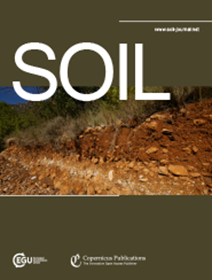评估通过露天排水沟筑坝重新湿润农业泥炭土的影响:一种农业地球物理方法
IF 4.3
2区 农林科学
Q1 SOIL SCIENCE
引用次数: 0
摘要
摘要。明渠筑坝旨在提高农业草地泥炭土的地下水位,从而减少温室气体(GHG)排放。目前的一个知识差距是如何审查这种行动的空间和时间有效性,即评估邻近油田地下水位的行为。为了解决这一问题,在一个排水的农业草地上,有浅泥炭土(深度从0到2米不等),通过安装大坝来提高露天排水沟的水位。通过在相邻油田的两个位置(Rewetted和Normal区域)安装的两个倾角井巢,监测了地下水位(WTD)的相关变化。在这两个地区获得了土壤剖面体积含水量(VWC)数据,以及露天排水中水的温度、盐度、pH和电导率特征。这些数据与夏季和冬季进行的地球物理(电磁感应(EMI))调查数据相结合。探井(位于>;距离大坝20 m)表明,大坝的安装没有造成可测量的WTD变化,这与先前的研究一致,表明农业沼泽泥炭土的空间影响有限。VWC剖面与泥炭的物理性质一致,没有显示出因泄水闸堵塞而产生的偏差。电磁干扰结果确定了一个明显的区域,其电导率值与露天排水的电导率值相似,表明夏季在水坝排水约20米范围内存在局部水渗透。这种空间影响在冬季不太明显,可能是由于降水增加和区域地下水的影响。该研究表明,电磁干扰调查与其他高分辨率数据捕获相结合,当与神经网络聚类和多聚类平均标准差分析相结合时,可以检测到再润湿效应,突出了其对快速现场评估的价值。此外,调查结果强调了调查时间的重要性,因为夏季测量比冬季测量提供了更清晰的排水大坝影响证据。本文章由计算机程序翻译,如有差异,请以英文原文为准。
Assessing the impact of rewetting agricultural fen peat soil via open drain damming: an agrogeophysical approach
Abstract. Open drainage ditch (i.e. open drain) damming aims to raise the water table in agricultural grassland peat soils thereby reducing greenhouse gas (GHG) emissions. A current knowledge gap is how to examine the spatial and temporal effectiveness of such an action i.e., assessing the behaviour of the water table in the adjoining field. To address this gap, at a drained agricultural grassland site with shallow fen peat soils (ranging from 0 to 2 m depth), water level in an open drain was raised by installing a dam. Associated changes to the water table depth (WTD) were monitored using two nests of dip wells installed at two locations (Rewetted and Normal areas) in the adjoining field. Soil profile volumetric water content (VWC) data were obtained in these two areas in addition to the temperature, salinity, pH, and electrical conductivity signature of the water in the open drain. These data were integrated with geophysical (electromagnetic induction (EMI)) survey data conducted during summer and winter. Results from the dip wells (located > 20 m from dam) indicated that no measurable change in WTD occurred due to the dam installation, aligning with previous studies suggesting limited spatial influence in agricultural fen peat soils. VWC profiles, while consistent with peat physical properties, showed no deviation attributable to drain damming. The EMI results identified a distinct zone with electrical conductivity values similar to those of open drain water, suggesting localised water infiltration within ~20 m of the dammed drain during summer. This spatial impact was less evident during winter, likely due to increased precipitation and regional groundwater influence. This study demonstrates that EMI surveys, shown here in combination with other high-resolution data capture, can detect rewetting effects when combined with neural network clustering and Multi-Cluster Average Standard Deviation analysis, highlighting its value for rapid site assessment. Moreover, the results underscore the importance of survey timing, as summer measurements provided clearer evidence of drain damming impact than winter measurements.
求助全文
通过发布文献求助,成功后即可免费获取论文全文。
去求助
来源期刊

Soil
Agricultural and Biological Sciences-Soil Science
CiteScore
10.80
自引率
2.90%
发文量
44
审稿时长
30 weeks
期刊介绍:
SOIL is an international scientific journal dedicated to the publication and discussion of high-quality research in the field of soil system sciences.
SOIL is at the interface between the atmosphere, lithosphere, hydrosphere, and biosphere. SOIL publishes scientific research that contributes to understanding the soil system and its interaction with humans and the entire Earth system. The scope of the journal includes all topics that fall within the study of soil science as a discipline, with an emphasis on studies that integrate soil science with other sciences (hydrology, agronomy, socio-economics, health sciences, atmospheric sciences, etc.).
 求助内容:
求助内容: 应助结果提醒方式:
应助结果提醒方式:


